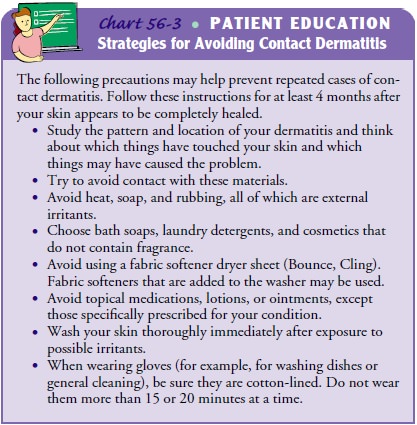Chapter: Medical Surgical Nursing: Management of Patients With Dermatologic Problems
Contact Dermatitis
Contact Dermatitis
Contact
dermatitis is an inflammatory reaction of the skin to physical, chemical, or
biologic agents. The epidermis is damaged by repeated physical and chemical
irritations. Contact dermatitis may be of the primary irritant type, in which a
nonallergic reac-tion results from exposure to an irritating substance, or it
may be allergic (ie, allergic contact dermatitis), resulting from exposure of
sensitized people to contact allergens. Common causes of irritant dermatitis
are soaps, detergents, scouring compounds, and industrial chem-icals.
Predisposing factors include extremes of heat and cold, fre-quent contact with
soap and water, and a preexisting skin disease (Chart 56-3).

Clinical Manifestations
The
eruptions begin when the causative agent contacts the skin. The first reactions
include itching, burning, and erythema, fol-lowed closely by edema, papules,
vesicles, and oozing or weeping. In the subacute phase, these vesicular changes
are less marked, and they alternate with crusting, drying, fissuring, and
peeling. If repeated reactions occur or if the patient continually scratches
the skin, lichenification and pigmentation occur. Secondary bacterial invasion
may follow.
Medical Management
The objectives of management are to rest the involved skin and protect it from further damage. The distribution pattern of the re-action is determined to differentiate between allergic and irritant contact dermatitis. A detailed history is obtained. If indicated, the offending irritant is removed. Local irritation should be avoided, and soap is not generally used until healing occurs.
Many
preparations are advocated for relieving dermatitis. In general, a bland,
unmedicated lotion is used for small patches of erythema (ie, red, inflamed
skin). Cool, wet dressings also are ap-plied over small areas of vesicular
dermatitis. Finely cracked ice added to the water often enhances its
antipruritic effect.
Wet dressings usually help clear the oozing
eczematous lesions. A thin layer of cream or ointment containing a
corticosteroid then may be used. Medicated baths at room temperature are
prescribed for larger areas of dermatitis. For severe, widespread conditions, a
short course of systemic corticosteroids may be prescribed.
Related Topics